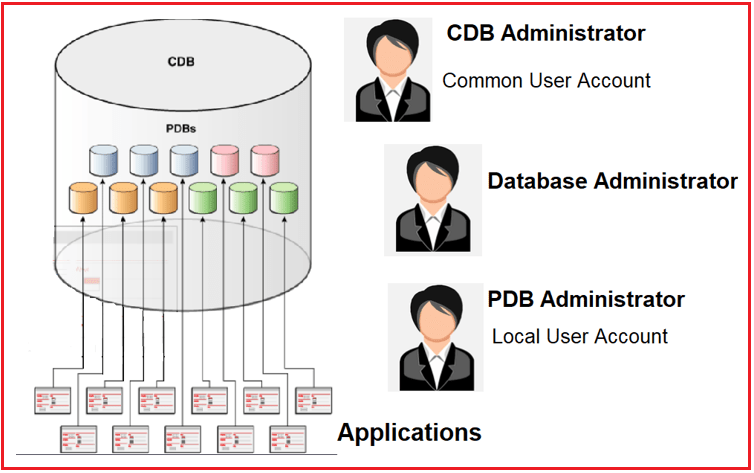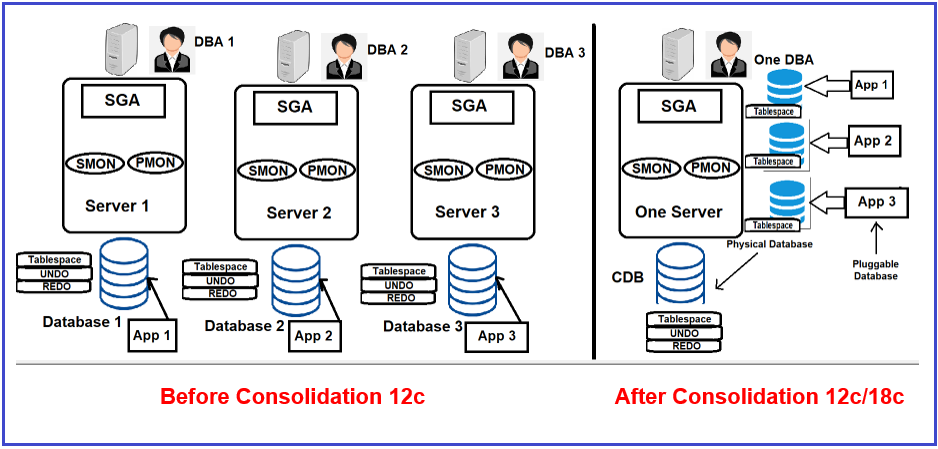Back to: Oracle DBA Tutorials
Oracle Multitenant Architecture 12c/18c
In this article, I am going to discuss Oracle Multitenant Architecture 12c/18c in Detail. Please read our previous article where we discussed Oracle Database Storage Structures in Detail.
What is Oracle Multitenant Architecture 12c/18c?
The concept of a multitenant database started from Oracle 12c,18c,19c, and later. I have a big database, a root database called as Container Database (CDB). It is just like a basket. It doesn’t contain any user data and the application data in the container database. In the container database, there are multiple pluggable databases that are isolated in the container database.
So, the users present in one pluggable database cannot access users in the other pluggable database. Unless there is a database link between two pluggable databases which we will discuss further. So, the DBA who manages the Container database is called as CDB Administrator. The DBA who manages the Pluggable database is called PDB Administrators. Even a single DBA can also manage these two roles.

What is the difference between a container database(12c) and a non-container database(11g)?
Before 12c there is an 11g version oracle database. In the 11g version, each database is connected to its server. In the below example, Database 1 is connecting to server1, and database 2 is connecting to server 2. Here we have many servers so it uses many resources to manage these databases. Now in 12c the container database there are pluggable databases present inside the container which saves the servers. Each pluggable database is connected to its own application.

Advantages of Oracle Multitenant Architecture:
- Reduce Cost: It reduces the servers and it takes only one server to manage so many databases.
- Saving Resources: Only one resource (DBA) is enough to manage all these pluggable databases.
- Easy Maintenance
- Easy Backup: No need to back up all the pluggable databases individually. We can backup container database only and it contains backup of all the pdb’s
- Easy Cloning: It is easy to clone the pluggable databases because it consumes less time.
- Separation of Rules: It separates the roles of CDB Administrator and PDB Administrator.
Every container Databases has the following process:

- Exactly one CDB root container called CDB$ROOT: We have only a root database. It has data files, metadata, and common users among the pluggable databases, and data is shared among all the databases in the container database.
- Seed PDB called PDB$SEED (it is a template): The Oracle default creates a seed pdb which is used to clone to create another pdb database. It is taken as a model template and new databases are created according to the configuration.
- Zero or more user-created PDBs: In the above picture we have two pluggable databases (PDB1, and PDB2) which were created from the temple of the PDB$SEED database.
Note: Starting from 12c R2 we have a new concept called Application container. This is the optional container. The application container database is a small CDB that is present in the root CDB.
In the next article, I am going to discuss Oracle DBA Tasks and Tools in detail. Here, in this article, I try to explain Oracle Multitenant Architecture 12c/18c and I hope you enjoy this Oracle Multitenant Architecture 12c/18c article.
Registration Open – Microservices with ASP.NET Core Web API
Session Time: 6:30 AM – 8:00 AM IST
Advance your career with our expert-led, hands-on live training program. Get complete course details, the syllabus, registration, and Zoom credentials for demo sessions via the links below.
